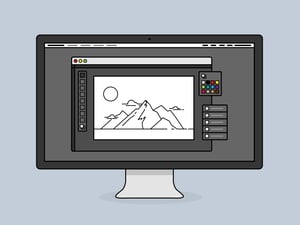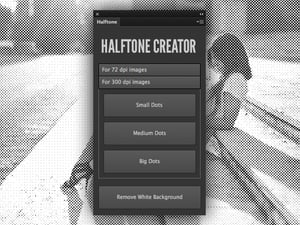
5 Photoshop Filters You Probably Don't Use (And What They Do)
A large part of my day to day job is creating design resources with Photoshop, including mockups, text effects and other fancy things like that. It often means I need to experiment with and use lots of Photoshop filters some of which seem almost useless at first. Here are 5 of those filters which have become surprisingly useful.
1. Filter > Other > Offset...
Now, out of all of the filters categorised as 'Other' in Photoshop, this is probably the most common and most useful of them. Offset.. works by taking an area of pixels on the canvas and moving (offsetting) them along the X and Y axis. When using the default settings for Offset.. any pixels that are moved off the canvas, will then wrap around and appear on the opposite side of the document, as if they are on a continuous loop like the corridors from Scooby Doo cartoons. The Wrap Around feature can be turned off if this isn't the desired effect.
The number one use for this filter has got to be making seamless patterns. If you take a regular texture in Photoshop and offset the pixels by 50% vertically and horizontally, you will be able to see the 'seams' where the texture repeats in the middle. Smooth over these seams and your texture can now be repeated seamlessly. Click here to read our tutorial on how to create a seamless texture using Offset.
2. Filter > Other > Minimum/Maximum...
If you use Adobe Illustrator, you are probably familiar with the feature 'Offset Path'. It works by manipulating vector objects or text layers to make them either thicker or thinner. It's extremely useful in Illustrator and it would be great if we also had this feature in Photoshop too. Unfortunately Photoshop cannot Offset Path, however the next best thing is to use Filter > Other > Minimum.. (for making things larger) or Filter > Other > Maximum.. (for making things smaller).
This is useful when you have an object which needs to be just slightly bigger or smaller. A good example is if for creating a displaced shadow, you can duplicate your object and on the bottom copy apply Maximum.. to make the object smaller/appear distant, then add a Gaussian Blur and black Color Overlay to create a shadow.
3. Filter > Filter Gallery... > Glass
Ew, right? Yes this effect is very ugly. You've probably used it once when you first installed Photoshop and not touched it since. Same thing goes for the Ocean Ripple filter, in fact I'm going to group these two together as variations of the same effect.
But the Glass and Ocean Ripple filters have an unconventional use which can come in very handy. If you draw a black to white gradient and apply one of these filters to it, you end up with a glossy effect which you can overlay on other graphics to give them the illusion of a reflective finish. Think magazine covers, vinyl stickers, reflective foil etc.
4. Filter > Blur > Lens Blur
Without a doubt, Gaussian Blur is everybody's go-to blur type. Why would you use anything else when Gaussian Blur does exactly what you expect a blur to do? Well, if you are working with photography in particular then the lesser used Lens Blur has a lot to offer.
My favourite part of Lens Blur is the ability to create realistic looking Bokeh effects. Crank the Radius and Highlights sliders up high and then experiment with the Threshold slider to get the right amount of bokeh, it can create some really nice looking effects.
5. Filter > Distort > Displace
The Displace filter can be quite off-putting to a lot of users because Photoshop doesn't really give much of an indication what it is going to do when you use it. And it also asks you to locate a file on your computer. But if you don't know what the effect is going to do, how do you know what sort of file you need to choose? I'll try to keep this simple as possible and say that Displace takes the pixel data from an image that you choose, and uses it to distort your selected layer in Photoshop. It reads light and dark areas in the file that you choose (called a displacement map) to decide whether to distort the corresponding pixels in your document and by how much.
A good use for this feature is when you are mocking up a graphic (for example, a logo) onto a textured surface. Create a separate .psb document containing only the background texture and use it as a displacement map on your graphic in the original document. Your graphic will appear to be contoured to the texture.
Conclusion
I know what you're probably thinking... People don't use these filters for a reason! But if you learn to manipulate them correctly they can produce great results. They are tools that you, and everybody else who owns Photoshop has available to them, so why not learn how to use them to your advantage?














Comments